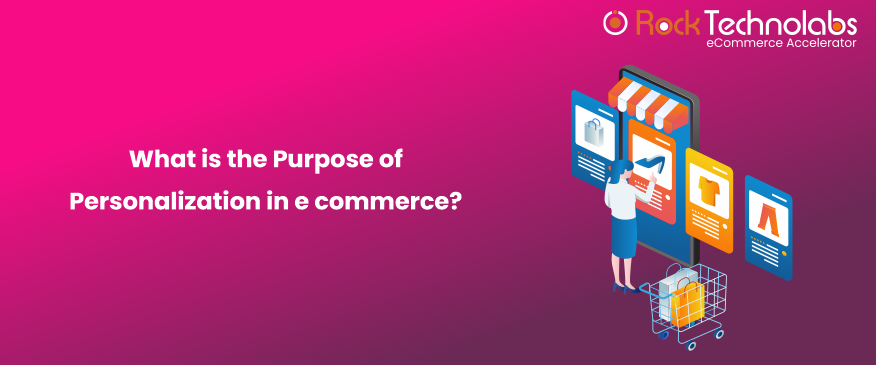Personalization in e-commerce: A Key to Convert Visitors into Customers

Personalization has become one of the marketing buzzwords over the last few years. It is something that has become common place today. There are numerous ways to personalize your customer experience. From emails to chatbots, from personalized websites to augmented reality, the possibilities seem endless. However, it can also be confusing. When should you personalize your eCommerce store? What are the pros and cons of each approach? How does Personalization impact conversions? And finally, what are some of the key elements that you should consider before implementing personalization?
Let us show you some ways how to create personalized experiences for your customers. We hope these tips will inspire you to come up with new ideas on how to improve your product experience.
What is eCommerce Personalisation?
Ecommerce personalization has become a standard practice in e-retailers across the globe. The reason why is obvious – increasing customer satisfaction and improving conversions.
Ecommerce Personalization refers to the use of technology to personalize a website based on customer data. ECommerce Personalization means using the data you collect through eCommerce tools to offer better marketing insights and services. In today’s ever-changing marketplace, it becomes crucial to gain insight into the behavior of your audience and adapt accordingly to maximize growth. Typically, customer information is passed between website owners and third-party service providers via APIs (application programming interfaces).
What is the purpose of personalization in e-commerce?
The purpose of personalization in e-commerce is to create a unique online experience for each shopper, making purchase decisions more relevant to them. Personalization allows retailers to deliver a tailored message to their customers based on past behaviors and preferences. At its core, it is about providing a higher level of customer service and enhancing the shopping experience for both consumers and businesses.
Through personalization, retailers can increase consumer retention and loyalty by targeting shoppers at different points throughout their journey (awareness, consideration, purchase) and with messages that are more relevant to their interests, buying habits, and preferences.
Retailers achieve greater conversion rates, lower abandonment rates, and gain increased insights into the behavior of individual consumers and their patterns of spending. In short, personalization increases revenues and reduces costs for both retailers and consumers.
Why is personalization important?
Personalization has become a buzzword recently. What does it really mean? Is it something new or old? Are you already using it? How can you benefit from it?
Personalization is basically giving customers exactly what they want, at the moment they want it. You are aiming to cater to each individual customer’s preferences, lifestyles, and interests. The idea behind this concept is to provide them with precisely the information they want, when they want it, and where they want to get it.
Personalization has become a standard feature in ecommerce. For instance, Amazon uses it to suggest items based on previous purchases or other data collected via cookies. Personalization helps businesses optimize their marketing strategies. Making small tweaks can have a significant impact on your business’s profitability.
Personalized emails have become one of the important customer retention strategies in retail. From startups to large corporations, there is no shortage of companies who are using data analytics, machine learning, and other technologies to create personalized experiences for their customers.
It is no secret that eCommerce personalization boosts profitability in several ways. We’ve put together some ecommerce personalization statistics and how eCommerce personalization can increase profit margin below.
- 80% of consumers are more likely to buy from a company that provides a tailored experience
- 66% of consumers expect brands to understand their individual needs
- 60% of marketers say their digital content is extensively or very extensive personalized
- Personalization increases marketing spend efficiency by as much as 30%
- Marketers have reported a 760% increase in email revenue attributed to personalized and segmented emails.
What are the benefits of personalization?
Personalization is one of the key advantages of eCommerce. Let’s have a look at the other benefits.
Increase Conversions
If you can grab attention with customized content and don’t distract them from their purpose to explore your website. You can persuade them to purchase from your store.
Reduces time spent shopping
Personalization enables retailers to focus on customers who have shown interest in their products, rather than wasting valuable marketing budget on those who haven’t. As a result, they spend less time researching what consumers want and need to buy, and more time getting to know them personally. By tailoring a product search based on their specific tastes, preferences, and history, retailers can help buyers find exactly what they’re looking for without having to shop around.
Boosts brand recognition
With personalization, consumers become familiar with individual brands and products, making it easier for them to recognize what they’re looking at, and helping them to feel confident in their purchase decision. Consumers also tend to trust companies more if they believe that they’ve actually met someone before – meaning that they’ll have a stronger connection to the brand before buying.
Increases customer lifetime value (LTV)
In an omnichannel world where shoppers often research and purchase items online and offline, personalized e-retailers have access to a wealth of data about customers which helps them identify trends and patterns, boosting LTV. It also means that retailers can optimize their website and mobile apps to make purchasing as simple as possible, ensuring that customers don’t get lost along the way.
Gives rise to loyalty programs
Personalizing the user experience allows retailers to segment their audience, giving them insight into each shopper’s preferences and behaviors. This makes it easier for them to create targeted offers and promotions, resulting in increased engagement and loyalty among existing customers, while encouraging repeat purchases among new ones.
Provides greater control over inventory
Personalization is just one of many ways that retailers can manage their inventory costs and supply chain logistics. When targeting consumers with similar preferences and habits, retailers can avoid stocking unnecessary inventory, reduce wastage, and save money. Additionally, personalization gives retailers a chance to tailor their messages, helping them target their ads more effectively – ultimately lowering advertising expenses.
Some brands are the perfect eCommerce personalization examples.
Recommended Products – Adidas
Adidas suggests the relevant products to complete the look along with the product customers wish to buy or look at. This personalized experience is offered based on the purchase history, customer preference, browsing history, etc.

Use Chatbots as Stylists
Check out how H&M brand launched their chatbot service to provide style tips to their customers by asking a few questions about the user’s style by presenting photos and asking users to simply pick“1” or “2.”.

How do I Personalize my ecommerce?
Collect Relevant Data
One of the key elements of creating personalized experiences is being able to identify your unique customer profile. This means that you need to collect information from every interaction your customer makes with your site and apps, and for that, what can be the better than the analytics? If you don’t capture enough data, then you won’t get a complete picture of who your customer is and what they want.
To achieve this, you need to ask yourself three important questions:
What am I looking for? What problems does my customer have? How do I solve them?
Once you answer these questions, you can begin collecting the relevant data to build and refine your solution.
Use Targeted Email Marketing
Targeted email marketing requires that they send emails based on your customer’s preferences. This includes interests, demographics, location, purchases, etc. As well as this, it helps improve conversion rates by allowing them to target specific people rather than just sending something out to everyone. When using targeted email marketing, businesses should make sure to have clear subject lines and use personalized content.
Add Videos To Landing Pages & Emails
Adding videos to landing pages and emails increases conversions by 42%, according to a study done by HubSpot. Videos help consumers understand the product better, and it also shows how much time the company spends on its products.
Show More Reviews On Product Page
People trust reviews posted online because they are unbiased and honest. If a business has good ratings, then customers tend to choose them more often. If a business does not have any reviews, they are less likely to buy from them, causing a loss in revenue. Customers who read reviews are about 30% more likely to purchase from a business compared to those who do not.
Recommend product
One of the most effective ways to personalize customer experience is to show related products or recommend the products to them. Best Seller recommendations, Featured Products, and Relevant Products are some great ways when you do not know a lot about your customer. It gives you an opportunity of suggesting or recommend something that fits your particular needs.
Exclusive coupons and giveaways
In addition to offering personalized product recommendations and discounts, some brands give customers exclusive access to freebies and free samples. If they’re lucky enough to win a giveaway, they’ll get something extra special.
Create a consistent look and feel
Make sure that each page looks similar – whether you have categories, products, images, videos, etc. A unified design creates a memorable impression on visitors for your brand.
Make it interactive
Don’t leave your website without adding interactivity features. People want to get involved, and providing them with the opportunity to navigate through your site using clickable buttons, links and videos make them feel connected.
Keep it simple
Creating a complex interface can be confusing. If possible, stick to only required and mandatory pages. Remember, fewer pages mean quicker loading times, meaning faster shopping experiences for your customers.
Add social sharing options
People often find it difficult to share links and content. But, if you have Facebook and Instagram accounts, add sharing buttons to your website to increase traffic and engagement.
Optimize your store
There’s no point in having a beautiful website if nobody ever visits it! Ensure that search engines know about your site by optimizing it. Search engine ranking is based on certain criteria including keyword density, backlinks, domain age, etc.
E-Commerce Personalization – A Prevalent Trend in the Industry
Personalization is now a part of everyday life and is becoming a fundamental pillar of ecommerce. As consumers’ demands increase, retailers are expected to deliver personalized experiences through the customer journey from shopping cart to check out.
In order to achieve optimal conversions, it is important to understand how customers behave during their purchase journeys. Once this behavior is known, retailers can then tailor strategies to enhance the customer experience. Need to enhance your commerce store and level up your personalization game? Contact us!







